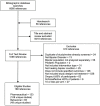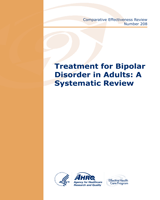NCBI Bookshelf. A service of the National Library of Medicine, National Institutes of Health.
Butler M, Urosevic S, Desai P, et al. Treatment for Bipolar Disorder in Adults: A Systematic Review [Internet]. Rockville (MD): Agency for Healthcare Research and Quality (US); 2018 Aug. (Comparative Effectiveness Review, No. 208.)
We identified 6060 unique citations (Figure 2) to May 2017 from bibliographic databases addressing drug, psychosocial, or other nondrug treatments for bipolar disorder (BD). Fifty-six articles were added through hand search. An initial title and abstract review excluded 4,971 articles that were not related to drug or nondrug treatments for patients with BD. Full texts of 1,145 articles were reviewed to determine final inclusion. Appendix D provides a list of articles excluded at full text.

Figure 2
Literature flow diagram.
We identified 188 unique publications eligible for inclusion, including 123 studies of drug treatments and their associated harms, and 65 focused on psychosocial and other physical treatments. An additional 62 publications, 57 drug and 5 psychosocial, were excluded for attrition greater than 50 percent; brief abstracts of these studies are provided in Appendix D.
Drug studies examined 28 separate drugs that were tested against 14 different types of comparators. These treatments and their comparators may have been single drug therapies or combination therapies of multiple drugs tested against either monotherapies or other multiple drug therapies. These then separated into 103 treatment comparisons, 59 of which had only one study contribute information. For Key Question 3, we found no studies meeting inclusion criteria that looked at treatments to reduce metabolic change side effects of drug treatments. Table 4 breaks the included studies down into each individual comparison for drug studies. Only five comparisons had four or more studies contributing. The populations tested in drug studies were overwhelmingly bipolar disorder I (BD-I) patients.
Table 4
Eligible unique studies by drug intervention and comparator.
Nondrug studies examined eight therapy approaches, seven of which were psychosocial intervention types: 1) psychoeducation, 2) cognitive behavioral therapy (CBT), 3) systematic/collaborative care, 4) family/partner interventions, 5) interpersonal and social rhythm therapy (IPSRT), 6) combination treatments (treatments that combined two or more psychosocial interventions, and 7) other psychosocial treatments (e.g. self-management via phone application support). A somatic therapy intervention, repetitive transcranial magnetic stimulation (rTMS), was examined as a nonpsychosocial, nondrug intervention. Each study represented a unique comparison due to differences in the structure of each intervention and control/comparator groups.
Table 5 provides the included studies for each individual comparison for nondrug studies. Comparators are categorized as inactive (e.g., usual care, no intervention) or active (e.g., a different psychosocial therapy, peer support) to indicate whether the studies were measuring the efficacy or effectiveness of the intervention. Since the nondrug studies were not as clearly delineated by BD states, the table further breaks down the studies by study enrollment criteria. For example, some studies may have required a particular BD state while other studies accepted BD participants in any state while still others may have excluded participants with a specific state.
Table 5
Eligible unique studies by nondrug intervention and comparator.
- Search Results - Treatment for Bipolar Disorder in Adults: A Systematic ReviewSearch Results - Treatment for Bipolar Disorder in Adults: A Systematic Review
Your browsing activity is empty.
Activity recording is turned off.
See more...
